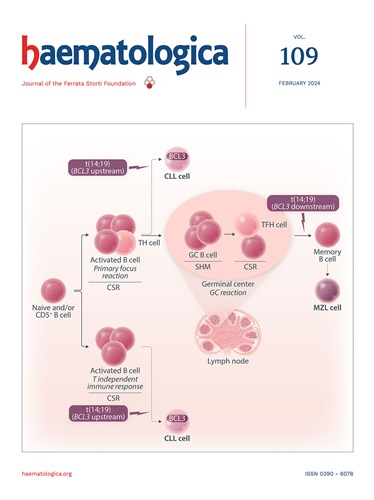Integrating killer cell immunoglobulin-like receptor high-resolution genotyping for predicting transplant outcomes in allogeneic hematopoietic stem cell transplantation.
IF 7.9
1区 医学
Q1 HEMATOLOGY
引用次数: 0
Abstract
The success of hematopoietic stem cell transplantation (HSCT) partly relies on the beneficial graft-versus-leukemia effect, mediated by alloreactive NK cells through their killer cell immunoglobulin-like receptors (KIR). Conflicting results have been reported regarding the impact of the KIR immunogenetic system on HSCT outcomes with a scarcity of data interrogating the effect of KIR allelic polymorphism. With the aim to fill this gap, donor KIR genes derived from a national cohort of 1247 HLA-matched transplanted donor/recipient pairs were determined at a high-resolution and tested in Cox proportional hazards models. Donor/recipient (D/R) pairs bearing a KIR2DS4*00101 - HLA-C1/C2/A11 interaction showed a significant detrimental impact on progression-free survival (PFS), overall survival (OS), transplant-related mortality (TRM) and chronic graft-versus-host disease (cGvHD) in multivariable analysis. Strong KIR2DL2/L3 - HLAC1 and especially KIR2DL3*00501 and *015 interactions showed a significant increase in the incidence of cGvHD compared to missing ligand D/R pairs. Highly inhibiting KIR3DL1 - HLA-B and HLA-A (Bw4) interactions were associated with a reduced relapse incidence as compared to weak and non-inhibiting interactions. Our study indicates that high-resolution KIR genotyping informs post-transplant outcomes with a seemingly higher protection of educated NK cells.整合杀伤细胞免疫球蛋白样受体高分辨率基因分型预测异体造血干细胞移植的移植结果。
造血干细胞移植(HSCT)的成功部分依赖于同种异体反应性NK细胞通过其杀伤细胞免疫球蛋白样受体(KIR)介导的有益移植物抗白血病效应。关于KIR免疫遗传系统对HSCT结果的影响,由于缺乏质疑KIR等位基因多态性影响的数据,报道了相互矛盾的结果。为了填补这一空白,从1247对hla匹配的移植供体/受体中提取的供体KIR基因在高分辨率下被确定,并在Cox比例风险模型中进行了测试。多变量分析显示,携带KIR2DS4*00101 - HLA-C1/C2/A11相互作用的供体/受体(D/R)对无进展生存(PFS)、总生存(OS)、移植相关死亡率(TRM)和慢性移植物抗宿主病(cGvHD)有显著的不利影响。与缺失配体D/R对相比,强KIR2DL2/L3 - HLAC1,尤其是KIR2DL3*00501和*015相互作用显著增加了cGvHD的发生率。与弱和非抑制性相互作用相比,高度抑制性KIR3DL1 - HLA-B和HLA-A (Bw4)相互作用与复发率降低相关。我们的研究表明,高分辨率的KIR基因分型对移植后的结果具有更高的保护作用。
本文章由计算机程序翻译,如有差异,请以英文原文为准。
求助全文
约1分钟内获得全文
求助全文
来源期刊

Haematologica
医学-血液学
CiteScore
14.10
自引率
2.00%
发文量
349
审稿时长
3-6 weeks
期刊介绍:
Haematologica is a journal that publishes articles within the broad field of hematology. It reports on novel findings in basic, clinical, and translational research.
Scope:
The scope of the journal includes reporting novel research results that:
Have a significant impact on understanding normal hematology or the development of hematological diseases.
Are likely to bring important changes to the diagnosis or treatment of hematological diseases.
 求助内容:
求助内容: 应助结果提醒方式:
应助结果提醒方式:


